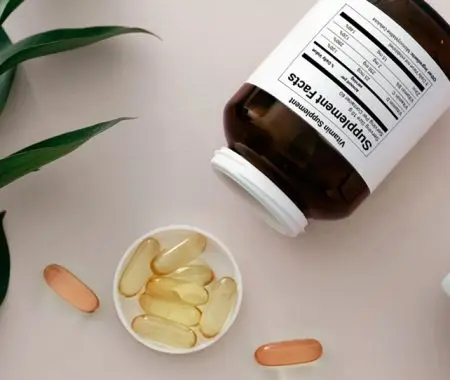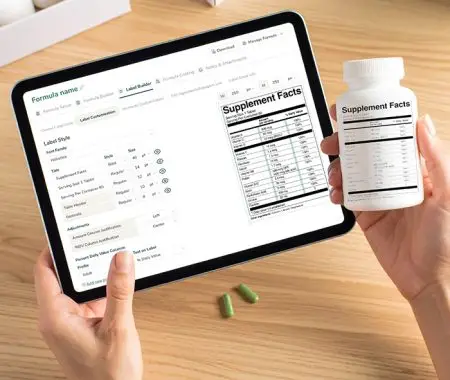Adding nutrition claims to your food and beverage products can help you upsell them to consumers, build trust through transparency, and differentiate your products from competitors.
It’s worth noting, however, that most consumers seek out the nutrition facts label and make decisions based on the information it provides.
To ensure your products are compliant and stand out on the shelf, you can create a free nutrition label using our software or view our pricing plans to find the perfect solution for your business.
See How FoodLabelMaker Can Help You
What are Nutrition Claims Exactly?
A nutrition claim is a statement on a food label that promotes the nutritional value of a product. This could be anything from indicating that the food is high in protein or low in sugar, to making specific health claims about the product.
What are the Different Types of Nutrition Claims?
There are many different types of nutrition claims that you might see on a food label. Some of the most common ones include:
- “High in Protein”
- To use this claim, the product must contain 20% or more of the Daily Value (DV) of protein per Reference Amount Customarily Consumed (RACC).
- The FDA also requires protein claims to factor in protein quality, measured by the Protein Digestibility-Corrected Amino Acid Score (PDCAAS).
- For a DV of 50g, the product must have at least 10g of high-quality protein per RACC.
- “Low in Sugar”
- The claim “Low in Sugar” cannot currently be used in the U.S., as the FDA has not defined this claim. The thresholds of 5g per 100g (solid) or 2.5g per 100ml (liquid) apply only in the EU and UK.
- In the U.S., manufacturers may instead use “Reduced Sugar,” which requires at least 25% less sugar than a reference product.
- “Good source of Fiber”
- A product can claim to be a “Good Source of Fiber” if it contains 10–19% of the DV for fiber per serving, typically 2.5g or more.
- To make a “High in Fiber” claim, the product must contain 20% DV or more, which is 5g or higher per serving.
However, not all nutrition claims are created equal. In order to make a nutrition claim on a food label, the product must meet certain conditions set out by legislation. For example, any health claims (i.e. “Diets low in saturated fat and cholesterol may reduce the risk of heart disease”) made about a product must be approved by the government before they can be used on a label.
Are there certain conditions to meet before making a Nutrition Claim?
In the U.S., food manufacturers can make nutrition claims on most products, even if they are high in fat, sugar, or salt. However, to use the term “healthy,” the product must meet strict FDA limits for nutrients such as saturated fat, sodium, and cholesterol. HFSS rules that completely restrict claims apply mainly in the UK and EU, and are not as highly enforced in the U.S. This is because those ingredients can be harmful to the consumers’ health if eaten in large quantities.
This rule is in place to protect consumers, as it would be misleading for them to see a claim on a product that is high in unhealthy ingredients. It would give the impression that the food is healthy when it is not.
Some foods and beverages can make health claims, others cannot. In the United States, the Food and Drug Administration (FDA) regulates what health claims can be made on food packaging.
There are a few general rules that govern when a food or beverage can make a nutrition claim.
- The food or beverage must meet specific nutrient criteria set by the FDA for each type of claim. For example, to qualify as a “Good Source” of a nutrient like fiber, a product must contain 10–19% of the Daily Value (DV) per serving.
- The food or beverage can only make disease-related claims if they are FDA-approved health claims supported by strong scientific evidence. For example, a product may state, “Diets low in saturated fat and cholesterol may reduce the risk of heart disease,” but it cannot make unapproved claims such as “prevents cancer” or “aids in weight loss.”
- The food or beverage must be properly labeled with all of the required information, including its ingredients and Nutrition Facts panel.
Who Regulates Nutrition Claims?
There are a number of pieces of legislation that govern the claims that can be made about nutrition. The most important one is the Food, Drug, and Cosmetic Act (FDCA), which sets out the rules for what can and cannot be included on food labels. The FDCA specifically requires that all health claims be reviewed and authorized by the US Food and Drug Administration (FDA) before they can appear on food packaging.
In addition to the FDCA, there are a number of other pieces of legislation that govern nutrition claims. The Nutrition Labeling and Education Act (NLEA) requires that most packaged foods display a Nutrition Facts panel with key information about the product’s nutritional content. This includes both mandatory nutrients (such as calories and fat) and voluntary nutrients (such as fiber and vitamin C). The NLEA also prohibits manufacturers from making any health claims that are not supported by scientific evidence.
The Federal Trade Commission (FTC) is responsible for ensuring that all advertising is truthful and accurate. This includes advertising for food products. If the FTC determines that a nutrition claim is false or misleading, they can take action against the manufacturer.
So, what legislation governs nutrition claims? The FDCA, the NLEA, and the FTC all play a role in ensuring that claims about the nutritional content of food are accurate and truthful.
How Can “Food Label Maker” Help with Making Nutrition Claims?
Food Label Maker is a powerful tool that can help you create accurate nutrition claims for your products. The software uses a unique nutrition algorithm to generate suggested nutrition claims based on the ingredients in your recipe and their quantities.
What’s more, Food Label Maker makes it easy to create nutrition claims that meet certain nutrient thresholds, ensuring your product complies with relevant regulations.
Get started today by creating a free nutrition label or view our pricing plans to find the best option for your business.



